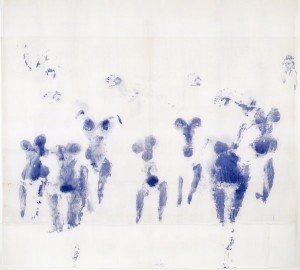A guest post by Brooke Kellaway, Getty Fellow, Visual Arts, Walker Art Center.
In the Walker Art Center’s library there are shelves of collection catalogues from museums around the world, dating from the mid 1900s. Since museums have the means to publish these books only once every several years (or decade), the care put into each is sometimes so intensive that the books themselves seem as special as the art written about inside of them. They capture events—cultural moments based on the stories told, works featured, design decisions made, and contributing writers selected.
What will become of collection catalogues in print when collection catalogue websites become increasingly prevalent? I’d like to think of the latter not as replacements for the book (long live it!) or upgrades of database-driven websites, but as the result of the best of both formats remade into something new and great…
The Walker Art Center’s next collection catalogue will launch on collections.walkerart.org later this year. We’ve radically expanded the book model and are completely revamping the collection website to create a dynamic media-rich space for vast (and free) information on works of art in the Walker’s collection.
The online catalogue entries will provide interested art historians, professionals, students, and the general public with updated material and a range of critical perspectives on the works. For example, the online entry for Yves Klein’s Suaire de Mondo Cane (Mondo Cane Shroud) (1961), will provide multiple high-resolution images of the painting with close-ups of the International Klein Blue pigment on the gauze fabric, several videos about the work’s conservation treatment and the process of installing it in the gallery, and an on-camera interview with the curator who researched the work before its acquisition. Scholarly essays will be included, as well as a detailed presentation history with floor plans and checklists, a bibliography with cited texts hyperlinked or embedded, and the work’s provenance.

This new collection catalogue will be perpetually in production, featuring new entries with every new acquisition. It’s a sensible step for the Walker, being that in the past several years the generation and storage of information on artworks has been primarily through electronic systems (from typed wall labels to digital photography and video to artist correspondence). It’s the same at other museums, as evidenced in the collection pages of San Francisco Museum of Modern Art or Museum of Contemporary Art Australia, and these online catalogues by the Corcoran and Rijksmuseum. With ever more sophisticated collection management databases, digital asset management systems, web publishing software, and interactive technologies, the documentation and interpretation of collection works is happening in the virtual world much more frequently.
The Walker’s catalogue is being built with the support of the Getty Foundation’s Online Scholarly Catalogue Initiative (OSCI) grant. The nine participating museums have considered the elements that make their printed books excellent resources (from thoroughly researched essays to useful glossaries and maps) and are incorporating these aspects into their collection websites with content that is current, searchable, and links out to a wider spectrum of both the museum’s activities and scholarship originating from elsewhere. Some of them emulate the look and feel of a book, while others explore alternative interfaces. For more information on their progress, the Getty just released its OSCI report that gathers the museum grantees’ experiences in publishing these new multifaceted collection catalogues.
I recently read the New York Times article, A Vast Museum That You Can Carry, reviewing the Metropolitan Museum of Art’s new 449-page guidebook. Ken Johnson wrote, “How useful the new guide will be when anything you want to know about the Met and its holdings can be quickly accessed on the museum’s world-class Web site is an interesting question.” It’s an interesting question indeed, and one that we at the Walker look forward to investigating as we work on melding the best of the book with the amazing possibilities offered by digital publishing.